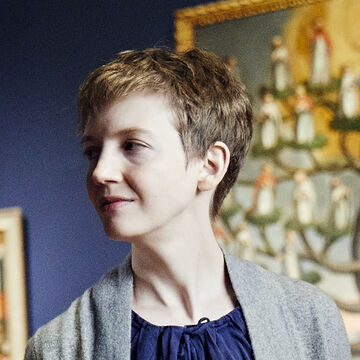

Annie Bourneuf
Professor
Contact
Bio
Education: BA, magna cum laude, 2001, Harvard University; MA, 2006, PhD, 2011, Princeton University. Awards: 2024-25 Robert Sterling Clark Visiting Professor in Art History, Williams College; 2020 Dedalus Foundation Senior Fellowship; 2019 David Baumgardt Memorial Fellowship, Leo Baeck Institute; 2016 Robert Motherwell Book Award; 2016 Jean Goldman Book Prize; Felix Gilbert Residential Fellowship, Institute for Advanced Study, Princeton; Alexander von Humboldt-Stiftung, Research Fellowship for postdoctoral researchers.
Personal Statement
My research interests center on modernism, mostly in Central Europe, with an emphasis on its relations with politics, technologies of reproduction, religion, and class. A new project reexamines cultural pessimism.rs around them, such as kissing, hiding, defacing, visualizing, and meditating.
Books
- Behind the Angel of History: The Angelus Novus and Its Interleaf (Chicago: University of Chicago Press, 2022)
- Paul Klee: The Visible and the Legible (Chicago: University of Chicago Press, 2015)
- Awarded the 2016 Robert Motherwell Book Award
- Awarded the 2016 Jean Goldman Book Prize
Selected Recent Articles and Book Chapters
- "Lucia Moholy's Documentation Service." In Lucia Moholy exhibition catalogue, ed. Jordan Troeller (Prague: Kunsthalle Praha, 2024), in press.
- "Type/Face: Wassily Kandinsky and Walter Benjamin on Language and Perception." In German Expressionism: Der Blaue Reiter and Its Legacies, ed. Dorothy Price, Manchester University Press, 2020
- "Otti Berger's bauhaus picture book." In The Bauhaus and Harvard, ed. Laura Muir, Harvard Art Museums, 2020
- “Interfaces and Proxies: Placing Moholy-Nagy’s Prints,” Leonardo 50, no. 3 (2017), special section “In Focus: László Moholy-Nagy,” ed. Maria Kokkori, Joyce Tsai, and Francesca Casadio
- "An Art of Privacy?: Wilhelm Hausenstein on Paul Klee." In Paul Klee: Making Visible exhibition catalogue, ed. Matthew Gale, Tate Modern (London: Tate Publishing, 2013).
Republished in Painting: Critical and Primary Sources, ed. Beth Harland and Sunil Manghani (London: Bloomsbury, 2015) - "Picasso, Braque, and the Uses of the Print, 1910-1912." In Picasso and Braque: The Cubist Experiment, 1910-12 exhibition catalogue, ed. Eik Kahng, Santa Barbara Museum of Art (New Haven: Yale University Press, 2011).
- "'Radically Uncolorful Painting': Walter Benjamin and the Problem of Cubism." In Grey Room 39 (Spring 2010), special issue on Walter Benjamin's Media Tactics: Optics, Perception, and the Work of Art, ed. Michael W. Jennings and Tobias Wilke.
- "A Refuge for Script: Paul Klee's Square Pictures." In Bauhaus Construct: Fashioning Identity, Discourse, and Modernism, ed. Robin Schuldenfrei and Jeffrey Saletnik (London and New York: Routledge, 2009).
Recent Thesis Advisees
- Justice Henderson (2023), "Ed Clark's 'Reactions' to Paris and New York, 1952-66"
- Samantha Adams (2021), “Ambivalent Images, or Tracing Repetition Compulsion in the Visual Vocabulary of Georges Bataille’s Editing of Documents Magazine, 1929-1930”
- Gunnar Olseth (2021), “Touch and Vision in Claude Cahun's Irrational Objects”